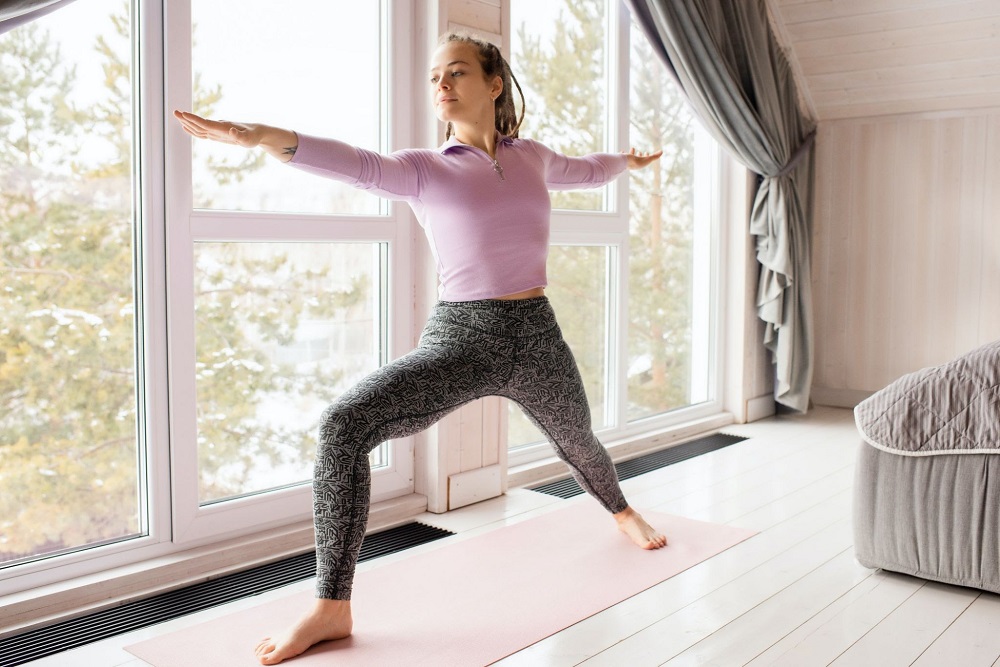Want to skip the noise of the commute and go straight into zen? Setting up a home studio saves you the trip of going to a yoga studio. It takes your practice to a more intimate level as yoga becomes a part of both your home and your lifestyle.
A home yoga studio can be an entire room, a corner of your living space or part of a multifunctional set-up that you can clear out when it’s time for your practice. The great thing about yoga is that you don’t need fancy equipment. All you need is a bit of space, a mat/towel to lie on and self-discipline to show up every day.
What Do You Need in A Home Yoga Studio?
To set up a home studio you need the basics: space and equipment. Here are a few tips on how to achieve a home yoga studio that works for you.
Space
Dedicate a place for your practice. Ideally, you should carve out and dedicate a place for your practice. This can be a nook or cranny where you can keep clean and let your yoga mat lay unrolled on the floor. So that each time you see it, it serves as an invitation to practice.
This may not work if you are dealing with limited space. In that case, you can always keep your yoga mat rolled at the corner within easy reach.
Have enough room to move around. The space you choose should be enough that you can lie down flat on top of your mat and have a bit more space to reach outside of it.
To achieve this in a tight space, you can move around some furniture to clear up space. You can also modify the poses to serve the space you are in. You can bend your elbows or your knees or stretch between spaces of lumpy furniture.
Take it outdoors. Having a tight space should not stop you from practicing. You can move your practice space around and test out the best place to focus on your asana. You can even try outdoors, on the balcony or the garden which will allow you to get some fresh air and a view of the sky.

Equipment
While you might be tempted to buy all of this equipment when making your home yoga studio, it is ideal to start with the ones you are sure you will use. Each piece of equipment has its uses but it depends on your practice if it will serve you and not just add to the clutter.
If you are a beginner, it is good to stick with the tools that you are familiar with. As you grow in your practice, you can incorporate more equipment that will allow you to go deeper into your poses.
Yoga mat
A yoga mat will provide a cushion for your joints. Choose mats with textured surfaces as these allow better grip and will keep your hands and feet from slipping. There are a variety of mats to choose from and your choice depends on your practice.
- Thinner mats help increase stability and are ideal for active yoga styles or poses that require balance.
- Thicker mats provide an extra cushion and are perfect for styles such as restorative yoga that requires you to hold poses for a longer amount of time.
- Travel mats are an option for those who are looking for portability. It is the ideal mat for those who travel a lot and want to make sure they can practice while on the go.
Tip: If you don’t have a yoga mat, you can use a towel as a substitute. It will protect your knees and also provide a clean surface for you to lie down.
Yoga Towel
Covering your mat with a full-length yoga towel improves hygiene. It absorbs sweat and moisture and makes your mat last longer. Its underside has grips that let it stay in place so you won’t slip during practice.
Yoga blocks
Yoga blocks are often used in class. It provides support for the back, head and hips and aids you in settling into a pose.
Tip: For yoga blocks, you can use thick books wrapped in a towel as a substitute.
Yoga Strap
Yoga straps are used for stretching to achieve a wider range of motion and improve your flexibility. It allows you to lean into the pose for a deeper stretch.
Tip: You don’t need to buy yoga straps if you’re tight on budget. You can use resistance bands or belts as a substitute. Check here for a booty band workout guide.

Meditation cushions
Meditation cushions lift your hips and roll them forward, helping you sit upright when meditating. It supports the natural curve and improves the alignment of your spine.
Tip: For meditation cushions, any pillow you can sit on will do as a substitute.
Yoga bolsters
Yoga bolsters help open up the body and help it relax. It softens postures and is perfect for restorative poses.
Tip: You can wrap a pillow in a blanket to create an oval shape for a makeshift Yoga Bolster.
Conclusion
Yoga can be done anywhere and at any time. Although it is good to have a set time in a day to practice, it is okay to allow some freedom and flexibility in your practice. Don’t be restricted by space, limited budget and not having yoga-specific equipment. Get creative and make use of what you have at home. But if you have time, you can visit any yoga studio within your locality.






